Impact of Spring Wheat Varieties and Legume Species Intercropping on Organic Wheat Production
Abstract
1. Introduction
2. Materials and Methods
2.1. Experimental Site and Weather Conditions
2.2. Wheat and Legume Varieties
2.3. Experimental Design and Cultivation of Wheat Varieties and Legumes
2.4. Nitrogen and Selected Nutrient Content in Soils and Plants
2.5. Crop Yields and Qualitative Characteristics
2.6. Statistical Analysis
3. Results and Discussion
3.1. Mineral Nitrogen (N) and Selected Nutrients Content in Soil Samples
3.2. Nitrogen and Selected Nutrient Content in Plants
3.3. Yield and Quality of the Spring Wheat
3.4. Principal Component Analysis (PCA) and Correlation Analysis
4. Conclusions
Supplementary Materials
Author Contributions
Funding
Data Availability Statement
Acknowledgments
Conflicts of Interest
References
- Tosti, G.; Farneselli, M.; Benincasa, P.; Guiducci, M. Nitrogen Fertilization Strategies for Organic Wheat Production: Crop Yield and Nitrate Leaching. Agron. J. 2016, 108, 770–781. [Google Scholar] [CrossRef]
- Lacko-Bartosova, M.; Lacko-Bartošová, L.; Konvalina, P. Wheat Rheological and Mixolab Quality in Relation to Cropping Systems and Plant Nutrition Sources. Czech J. Food Sci. 2021, 39, 265–272. [Google Scholar] [CrossRef]
- Oberson, A.; Jarosch, K.A.; Frossard, E.; Hammelehle, A.; Fliessbach, A.; Mäder, P.; Mayer, J. Higher than Expected: Nitrogen Flows, Budgets, and Use Efficiencies over 35 Years of Organic and Conventional Cropping. Agric. Ecosyst. Environ. 2024, 362, 108802. [Google Scholar] [CrossRef]
- Bedoussac, L.; Journet, E.-P.; Hauggaard-Nielsen, H.; Naudin, C.; Corre-Hellou, G.; Jensen, E.S.; Prieur, L.; Justes, E. Ecological Principles Underlying the Increase of Productivity Achieved by Cereal-Grain Legume Intercrops in Organic Farming. A Review. Agron. Sustain. Dev. 2015, 35, 911–935. [Google Scholar] [CrossRef]
- Mazzafera, P.; Favarin, J.L.; Andrade, S.A.L. de Editorial: Intercropping Systems in Sustainable Agriculture. Front. Sustain. Food Syst. 2021, 5, 634361. [Google Scholar] [CrossRef]
- Malézieux, E.; Crozat, Y.; Dupraz, C.; Laurans, M.; Makowski, D.; Ozier-Lafontaine, H.; Rapidel, B.; de Tourdonnet, S.; Valantin-Morison, M. Mixing Plant Species in Cropping Systems: Concepts, Tools and Models: A Review. In Sustainable Agriculture; Lichtfouse, E., Navarrete, M., Debaeke, P., Véronique, S., Alberola, C., Eds.; Springer: Dordrecht, The Netherlands, 2009; pp. 329–353. ISBN 978-90-481-2666-8. [Google Scholar]
- Duchene, O.; Vian, J.-F.; Celette, F. Intercropping with Legume for Agroecological Cropping Systems: Complementarity and Facilitation Processes and the Importance of Soil Microorganisms. A Review. Agric. Ecosyst. Environ. 2017, 240, 148–161. [Google Scholar] [CrossRef]
- Neugschwandtner, R.W.; Kaul, H.-P. Sowing Ratio and N Fertilization Affect Yield and Yield Components of Oat and Pea in Intercrops. Field Crops Res. 2014, 155, 159–163. [Google Scholar] [CrossRef]
- Jensen, E.S.; Carlsson, G.; Hauggaard-Nielsen, H. Intercropping of Grain Legumes and Cereals Improves the Use of Soil N Resources and Reduces the Requirement for Synthetic Fertilizer N: A Global-Scale Analysis. Agron. Sustain. Dev. 2020, 40, 5. [Google Scholar] [CrossRef]
- Tosti, G.; Guiducci, M. Durum Wheat–Faba Bean Temporary Intercropping: Effects on Nitrogen Supply and Wheat Quality. Eur. J. Agron. 2010, 33, 157–165. [Google Scholar] [CrossRef]
- Zhao, Y.; Tian, Y.; Li, X.; Song, M.; Fang, X.; Jiang, Y.; Xu, X. Nitrogen Fixation and Transfer between Legumes and Cereals under Various Cropping Regimes. Rhizosphere 2022, 22, 100546. [Google Scholar] [CrossRef]
- Amossé, C.; Jeuffroy, M.-H.; Mary, B.; David, C. Contribution of Relay Intercropping with Legume Cover Crops on Nitrogen Dynamics in Organic Grain Systems. Nutr. Cycl. Agroecosyst. 2014, 98, 1–14. [Google Scholar] [CrossRef]
- Peng, X.; Ren, J.; Chen, P.; Yang, L.; Luo, K.; Yuan, X.; Lin, P.; Fu, Z.; Li, Y.; Li, Y.; et al. Effects of Soil Physicochemical Environment on the Plasticity of Root Growth and Land Productivity in Maize Soybean Relay Strip Intercropping System. J. Sci. Food Agric. 2024, 104, 3865–3882. [Google Scholar] [CrossRef] [PubMed]
- Costanzo, A.; Bàrberi, P. Functional Agrobiodiversity and Agroecosystem Services in Sustainable Wheat Production. A Review. Agron. Sustain. Dev. 2014, 34, 327–348. [Google Scholar] [CrossRef]
- Michalitsis, A.; Papakaloudis, P.; Pankou, C.; Lithourgidis, A.; Menexes, G.; Dordas, C. Effect of Cultivar on Faba Bean–Wheat Intercrop Productivity under a Mediterranean Environment. Agronomy 2024, 14, 70. [Google Scholar] [CrossRef]
- Zustovi, R.; Landschoot, S.; Dewitte, K.; Verlinden, G.; Dubey, R.; Maenhout, S.; Haesaert, G. Intercropping Indices Evaluation on Grain Legume-Small Grain Cereals Mixture: A Critical Meta-Analysis Review. Agron. Sustain. Dev. 2024, 44, 5. [Google Scholar] [CrossRef]
- Paul, M.R.; Demie, D.T.; Seidel, S.J.; Döring, T.F. Evaluation of Multiple Spring Wheat Cultivars in Diverse Intercropping Systems. Eur. J. Agron. 2024, 152, 127024. [Google Scholar] [CrossRef]
- Brooker, R.W.; Bennett, A.E.; Cong, W.-F.; Daniell, T.J.; George, T.S.; Hallett, P.D.; Hawes, C.; Iannetta, P.P.M.; Jones, H.G.; Karley, A.J.; et al. Improving Intercropping: A Synthesis of Research in Agronomy, Plant Physiology and Ecology. New Phytol. 2015, 206, 107–117. [Google Scholar] [CrossRef] [PubMed]
- Poudel, D.D.; Horwath, W.R.; Lanini, W.T.; Temple, S.R.; van Bruggen, A.H.C. Comparison of Soil N Availability and Leaching Potential, Crop Yields and Weeds in Organic, Low-Input and Conventional Farming Systems in Northern California. Agric. Ecosyst. Environ. 2002, 90, 125–137. [Google Scholar] [CrossRef]
- Vrignon-Brenas, S.; Celette, F.; Piquet-Pissaloux, A.; Corre-Hellou, G.; David, C. Intercropping Strategies of White Clover with Organic Wheat to Improve the Trade-off between Wheat Yield, Protein Content and the Provision of Ecological Services by White Clover. Field Crops Res. 2018, 224, 160–169. [Google Scholar] [CrossRef]
- Nelson, W.C.D.; Siebrecht-Schöll, D.J.; Hoffmann, M.P.; Rötter, R.P.; Whitbread, A.M.; Link, W. What Determines a Productive Winter Bean-Wheat Genotype Combination for Intercropping in Central Germany? Eur. J. Agron. 2021, 128, 126294. [Google Scholar] [CrossRef]
- Hoang, T.N.; Konvalina, P.; Kopecký, M.; Ghorbani, M.; Nguyen, T.G.; Bernas, J.; Murindangabo, Y.T.; Capouchová, I.; Shim, S.; Hlásná Čepková, P. Assessing the Quality and Grain Yield of Winter Wheat in the Organic Farming Management under Wheat-Legume Intercropping Practice. Heliyon 2024, 10, e31234. [Google Scholar] [CrossRef] [PubMed]
- Hoang, T.N.; Konvalina, P.; Murindangabo, Y.T.; Capouchová, I.; Dvořák, P.; Tran, D.H. Improving Winter Wheat Yield and Quality by Wheat-Legume Intercropping in Organic Farming Sytems. Org. Agric. 2025. [Google Scholar] [CrossRef]
- Glaze-Corcoran, S.; Hashemi, M.; Sadeghpour, A.; Jahanzad, E.; Keshavarz Afshar, R.; Liu, X.; Herbert, S.J. Understanding Intercropping to Improve Agricultural Resiliency and Environmental Sustainability. Adv. Agron. 2020, 162, 199–256. [Google Scholar] [CrossRef]
- Huss, C.P.; Holmes, K.D.; Blubaugh, C.K. Benefits and Risks of Intercropping for Crop Resilience and Pest Management. J. Econ. Entomol. 2022, 115, 1350–1362. [Google Scholar] [CrossRef]
- Verret, V.; Gardarin, A.; Pelzer, E.; Médiène, S.; Makowski, D.; Valantin-Morison, M. Can Legume Companion Plants Control Weeds without Decreasing Crop Yield? A Meta-Analysis. Field Crops Res. 2017, 204, 158–168. [Google Scholar] [CrossRef]
- Bergkvist, G. Effect of White Clover and Nitrogen Availability on the Grain Yield of Winter Wheat in a Three-Season Intercropping System. Acta Agric. Scand. Sect. B-Soil Plant Sci.-Acta Agr. Scand. Sect. B-Soil PL 2003, 53, 97–109. [Google Scholar] [CrossRef]
- Dvořák, P.; Capouchová, I.; Král, M.; Konvalina, P.; Janovská, D.; Satranský, M. Grain Yield and Quality of Wheat in Wheat-Legumes Intercropping under Organic and Conventional Growing Systems. Plant Soil Environ. 2022, 68, 553–559. [Google Scholar] [CrossRef]
- Weih, M.; Karley, A.J.; Newton, A.C.; Kiær, L.P.; Scherber, C.; Rubiales, D.; Adam, E.; Ajal, J.; Brandmeier, J.; Pappagallo, S.; et al. Grain Yield Stability of Cereal-Legume Intercrops Is Greater than Sole Crops in More Productive Conditions. Agriculture 2021, 11, 255. [Google Scholar] [CrossRef]
- Klimek-Kopyra, A.; Zając, T.; Oleksy, A.; Kulig, B. Biological and Production Responses of Intercropped Plants of Pea, Spring Wheat, and Linseed. Acta Agrobot. 2018, 71, 1737. [Google Scholar] [CrossRef]
- Klimek-Kopyra, A.; Zaja¸c, T.; Re¸bilas, K. A Mathematical Model for the Evaluation of Cooperation and Competition Effects in Intercrops. Eur. J. Agron. 2013, 51, 9–17. [Google Scholar] [CrossRef]
- Neugschwandtner, R.W.; Kaul, H.-P. Nitrogen Uptake, Use and Utilization Efficiency by Oat–Pea Intercrops. Field Crops Res. 2015, 179, 113–119. [Google Scholar] [CrossRef]
- Jahn, R.; Blume, H.P.; Asio, V.; Spaargaren, O.; Schád, P. FAO Guidelines for Soil Description; Food and Agriculture Organization of the United Nations: Rome, Italy, 2006; ISBN 92-5-105521-1. [Google Scholar]
- Mehlich, A. Mehlich 3 Soil Test Extractant: A Modification of Mehlich 2 Extractant. Commun. Soil Sci. Plant Anal. 1984, 15, 1409–1416. [Google Scholar] [CrossRef]
- ICC Standard No. 105/2; Determination of Crude Protein in Cereals and Cereal Products for Food and Feed. International Association for Cereal Science and Technology: Vienna, Austria, 1994.
- ICC Standard No.107/1; Determination of the Falling Number according to Hagberg-Perten—As a Measure of the Degree of Alpha-Amylase Activity in Grain and Flour. International Association for Cereal Science and Technology: Vienna, Austria, 1968.
- ICC Standard No. 116/1; Determination of the Sedimentation Value (According to Zeleny) as an Approximate Measure of Baking Quality. International Association for Cereal Science and Technology: Vienna, Austria, 1972.
- ICC Standard No. 137/1; Mechanical Determination of the Wet Gluten Content of Wheat Flour (Glutomatic). International Association for Cereal Science and Technology: Vienna, Austria, 1982.
- ISO 7971-3:2019(E); Cereals -Determination of Bulk Density, Called Mass per Hectolitre. International Organization for Standardization: Geneva, Switzerland, 2019.
- Akchaya, K.; Parasuraman, P.; Pandian, K.; Vijayakumar, S.; Thirukumaran, K.; Firnass, M.; Rajpoot, S.; Choudhary, A. Boosting Resource Use Efficiency, Soil Fertility, Food Security, Ecosystem Services, and Climate Resilience with Legume Intercropping: A Review. Front. Sustain. Food Syst. 2025, 9, 1527256. [Google Scholar] [CrossRef]
- Chamkhi, I.; Cheto, S.; Geistlinger, J.; Zeroual, Y.; Kouisni, L.; Bargaz, A.; Ghoulam, C. Legume-Based Intercropping Systems Promote Beneficial Rhizobacterial Community and Crop Yield under Stressing Conditions. Ind. Crops Prod. 2022, 183, 114958. [Google Scholar] [CrossRef]
- Wang, Z.-G.; Jin, X.; Bao, X.-G.; Li, X.-F.; Zhao, J.-H.; Sun, J.-H.; Christie, P.; Li, L. Intercropping Enhances Productivity and Maintains the Most Soil Fertility Properties Relative to Sole Cropping. PLoS ONE 2014, 9, e113984. [Google Scholar] [CrossRef] [PubMed]
- Curtis, B.C.; Rajaram, S.; Gómez Macpherson, H. Bread Wheat—Improvement and Production; Food and Agriculture Organization of the United Nations: Rome, Italy, 2002; ISBN 92-5-104809-6. [Google Scholar]
- Lai, H.; Gao, F.; Su, H.; Zheng, P.; Li, Y.; Yao, H. Nitrogen Distribution and Soil Microbial Community Characteristics in a Legume–Cereal Intercropping System: A Review. Agronomy 2022, 12, 1900. [Google Scholar] [CrossRef]
- Kumar, K.; Goh, K.M. Biological Nitrogen Fixation, Accumulation of Soil Nitrogen and Nitrogen Balance for White Clover (Trifolium repens L.) and Field Pea (Pisum sativum L.) Grown for Seed. Field Crops Res. 2000, 68, 49–59. [Google Scholar] [CrossRef]
- Lo Presti, E.; Badagliacca, G.; Custureri, I.M.G.; Preiti, G.; Santonoceto, C.; Bacchi, M.; Romeo, M.; Monti, M. The Sowing Ratio in Legume Intercropping Regulates the Facilitation of Phosphorus Uptake in Wheat. Ital. J. Agron. 2024, 19, 100024. [Google Scholar] [CrossRef]
- Reilly, E.C.; Gutknecht, J.L.; Tautges, N.E.; Sheaffer, C.C.; Jungers, J.M. Nitrogen Transfer and Yield Effects of Legumes Intercropped with the Perennial Grain Crop Intermediate Wheatgrass. Field Crops Res. 2022, 286, 108627. [Google Scholar] [CrossRef]
- Richardson, A.E.; Hocking, P.J.; Simpson, R.J.; George, T.S. Plant Mechanisms to Optimise Access to Soil Phosphorus. Crop Pasture Sci. 2009, 60, 124–143. [Google Scholar] [CrossRef]
- Xue, Y.; Xia, H.; Christie, P.; Zhang, Z.; Li, L.; Tang, C. Crop Acquisition of Phosphorus, Iron and Zinc from Soil in Cereal/Legume Intercropping Systems: A Critical Review. Ann. Bot. 2016, 117, 363–377. [Google Scholar] [CrossRef] [PubMed]
- López-Arredondo, D.L.; Leyva-González, M.A.; González-Morales, S.I.; López-Bucio, J.; Herrera-Estrella, L. Phosphate Nutrition: Improving Low-Phosphate Tolerance in Crops. Annu. Rev. Plant. Biol. 2014, 65, 95–123. [Google Scholar] [CrossRef] [PubMed]
- Römheld, V.; Kirkby, E.A. Research on Potassium in Agriculture: Needs and Prospects. Plant Soil 2010, 335, 155–180. [Google Scholar] [CrossRef]
- Zörb, C.; Senbayram, M.; Peiter, E. Potassium in Agriculture—Status and Perspectives. J. Plant Physiol. 2014, 171, 656–669. [Google Scholar] [CrossRef]
- Trnka, M.; Možný, M.; Jurečka, F.; Balek, J.; Semerádová, D.; Hlavinka, P.; Štěpánek, P.; Farda, A.; Skalák, P.; Cienciala, E.; et al. Observed and Estimated Consequences of Climate Change for the Fire Weather Regime in the Moist-Temperate Climate of the Czech Republic. Agric. For. Meteorol. 2021, 310, 108583. [Google Scholar] [CrossRef]
- Zahradníček, P.; Brázdil, R.; Řehoř, J.; Lhotka, O.; Dobrovolný, P.; Štěpánek, P.; Trnka, M. Temperature Extremes and Circulation Types in the Czech Republic, 1961–2020. Int. J. Climatol. 2022, 42, 4808–4829. [Google Scholar] [CrossRef]
- Mitura, K.; Cacak-Pietrzak, G.; Feledyn-Szewczyk, B.; Szablewski, T.; Studnicki, M. Yield and Grain Quality of Common Wheat (Triticum aestivum L.) Depending on the Different Farming Systems (Organic vs. Integrated vs. Conventional). Plants 2023, 12, 1022. [Google Scholar] [CrossRef]
- Lithourgidis, A.S.; Vlachostergios, D.N.; Dordas, C.A.; Damalas, C.A. Dry Matter Yield, Nitrogen Content, and Competition in Pea–Cereal Intercropping Systems. Eur. J. Agron. 2011, 34, 287–294. [Google Scholar] [CrossRef]
- Manley, M.; Engelbrecht, M.L.; Williams, P.C.; Kidd, M. Assessment of Variance in the Measurement of Hectolitre Mass of Wheat, Using Equipment from Different Grain Producing and Exporting Countries. Biosyst. Eng. 2009, 103, 176–186. [Google Scholar] [CrossRef]
- Bilsborrow, P.; Cooper, J.; Tétard-Jones, C.; Średnicka-Tober, D.; Barański, M.; Eyre, M.; Schmidt, C.; Shotton, P.; Volakakis, N.; Cakmak, I.; et al. The Effect of Organic and Conventional Management on the Yield and Quality of Wheat Grown in a Long-Term Field Trial. Eur. J. Agron. 2013, 51, 71–80. [Google Scholar] [CrossRef]
- Przystalski, M.; Osman, A.; Thiemt, E.M.; Rolland, B.; Ericson, L.; Østergård, H.; Levy, L.; Wolfe, M.; Büchse, A.; Piepho, H.-P.; et al. Comparing the Performance of Cereal Varieties in Organic and Non-Organic Cropping Systems in Different European Countries. Euphytica 2008, 163, 417–433. [Google Scholar] [CrossRef]
- Murphy, K.M.; Campbell, K.G.; Lyon, S.R.; Jones, S.S. Evidence of Varietal Adaptation to Organic Farming Systems. Field Crops Res. 2007, 102, 172–177. [Google Scholar] [CrossRef]
- Annicchiarico, P.; Chiapparino, E.; Perenzin, M. Response of Common Wheat Varieties to Organic and Conventional Production Systems across Italian Locations, and Implications for Selection. Field Crops Res. 2010, 116, 230–238. [Google Scholar] [CrossRef]
- Sułek, A.; Cacak-Pietrzak, G.; Wyzińska, M.; Nieróbca, A. Influence of Nitrogen Fertilization on the Yields and Grain Quality of Winter Wheat under Different Environmental Conditions. Int. J. Agric. Biosyst. Eng. 2019, 13, 127–133. [Google Scholar]
- Dziki, D.; Cacak-Pietrzak, G.; Gawlik-Dziki, U.; Swieca, M.; Miś, A.; Różyło, R.; Jończyk, K. Physicochemical Properties and Milling Characteristics of Spring Wheat from Different Farming Systems. J. Agric. Sci. Technol. 2017, 19, 1253–1266. [Google Scholar]
- Marzec, A.; Cacak-Pietrzak, G.; Gondek, E. Mechanical and Acoustic Properties of Spring Wheat Versus Its Technological Quality Factors. J. Texture Stud. 2011, 42, 319–329. [Google Scholar] [CrossRef]
- Sulek, A.; Cacak-Pietrzak, G. The Influence of Production Technology on Yield and Selected Quality Parameters of Spring Wheat Cultivars. Agric. Sci. 2018, 2, 42–48. [Google Scholar] [CrossRef]
- Guiducci, M.; Tosti, G.; Falcinelli, B.; Benincasa, P. Sustainable Management of Nitrogen Nutrition in Winter Wheat through Temporary Intercropping with Legumes. Agron. Sustain. Dev. 2018, 38, 31. [Google Scholar] [CrossRef]
- Mazzoncini, M.; Antichi, D.; Silvestri, N.; Ciantelli, G.; Sgherri, C. Organically vs Conventionally Grown Winter Wheat: Effects on Grain Yield, Technological Quality, and on Phenolic Composition and Antioxidant Properties of Bran and Refined Flour. Food Chem. 2015, 175, 445–451. [Google Scholar] [CrossRef]
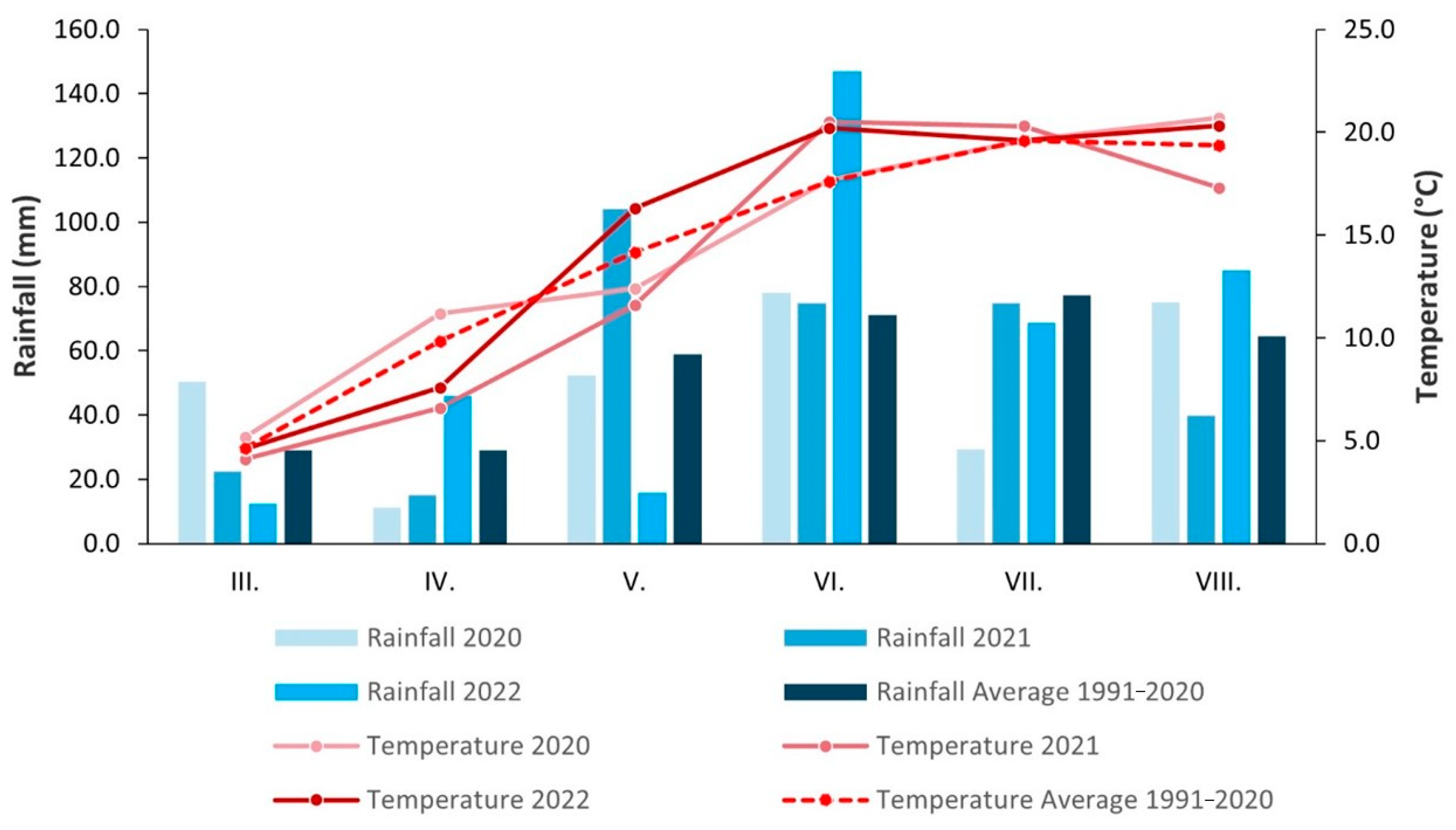
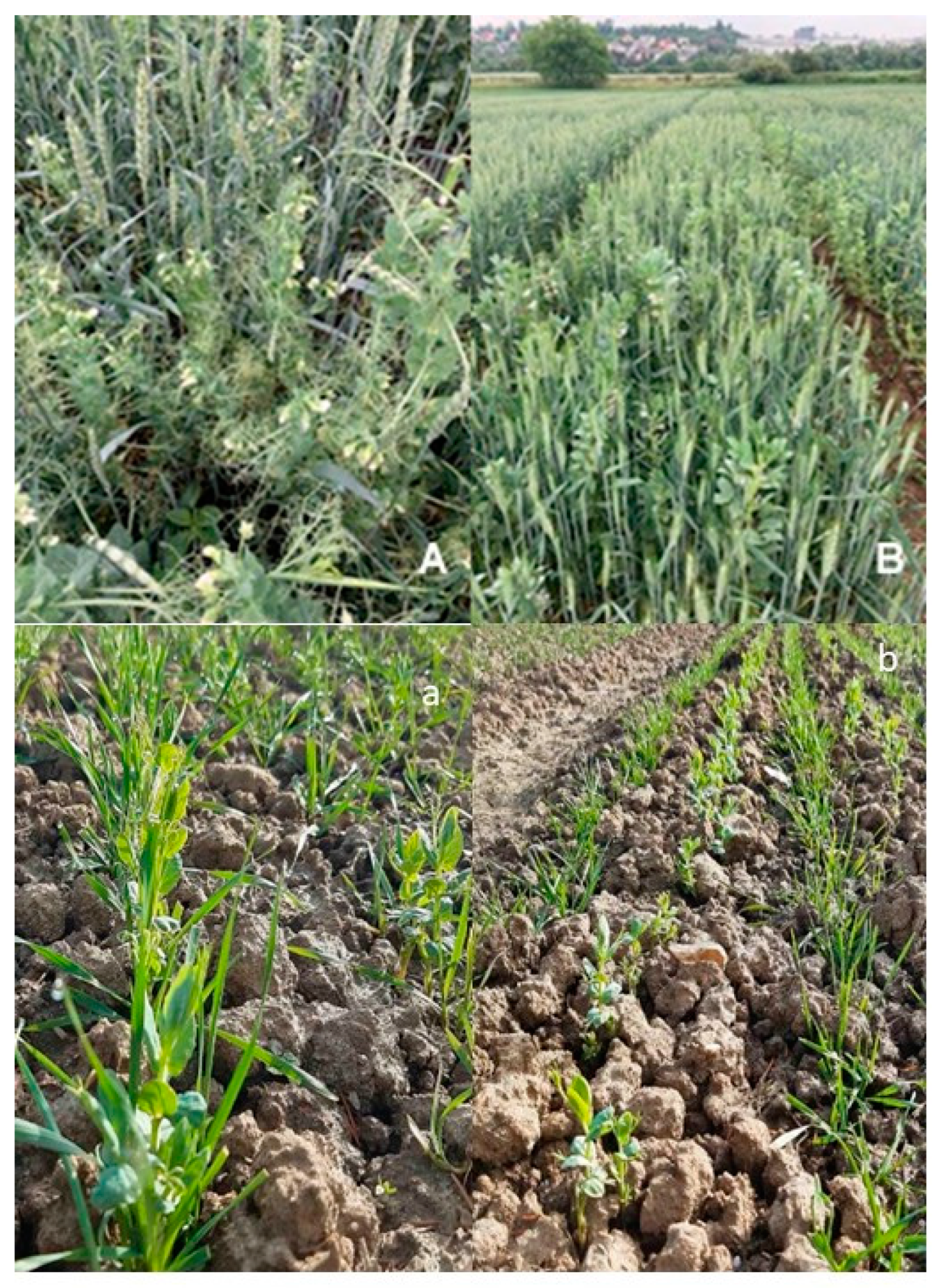

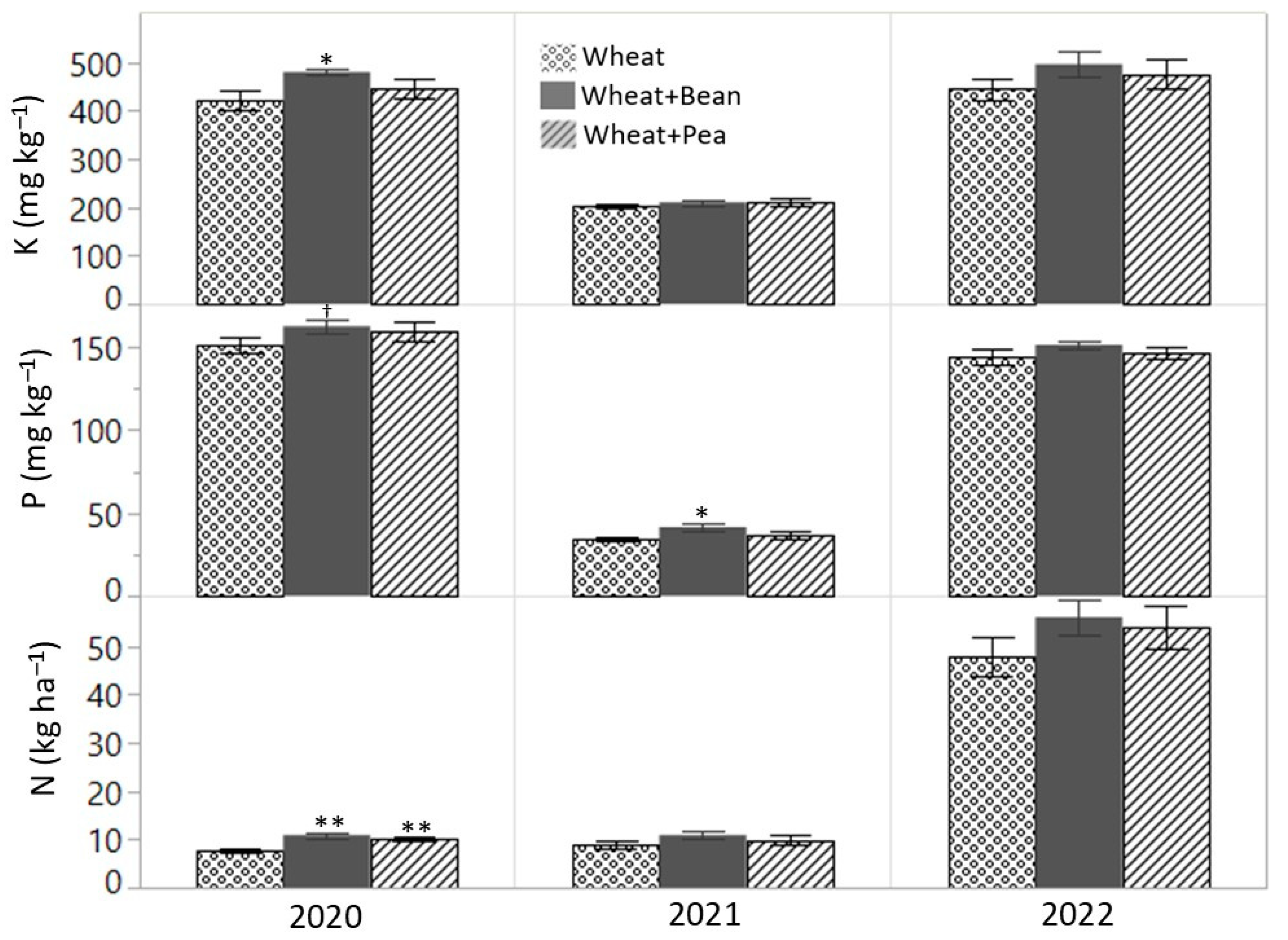
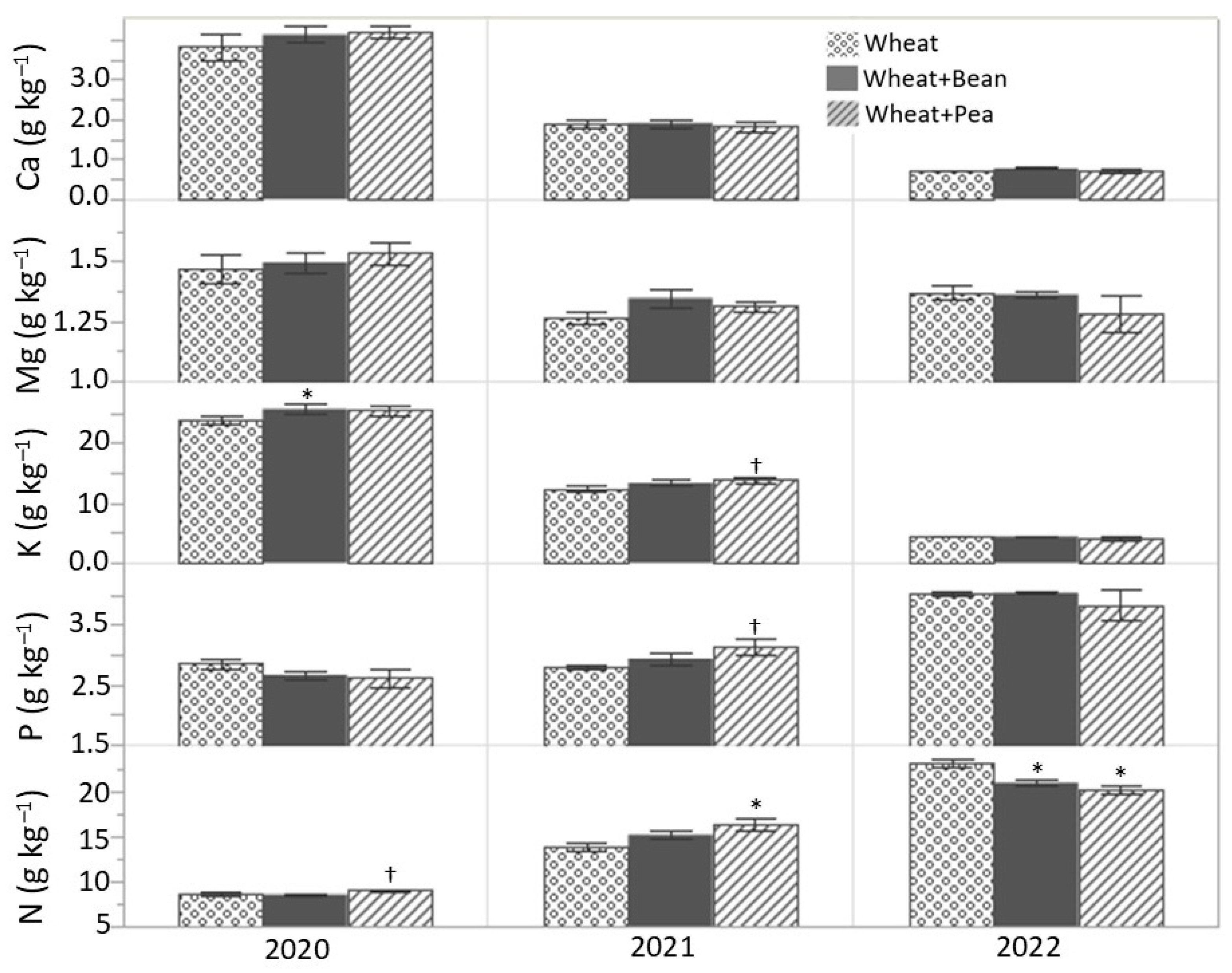

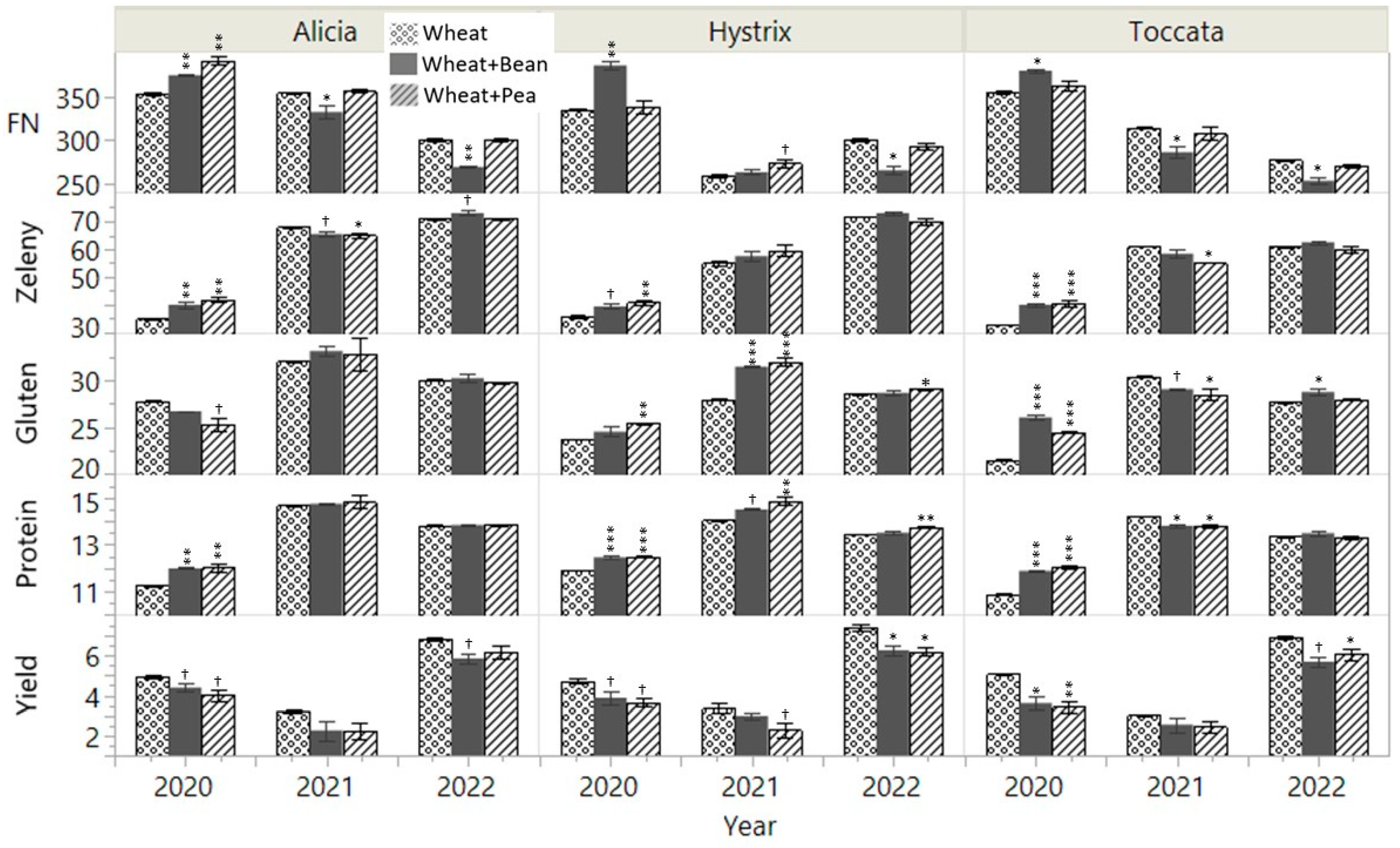
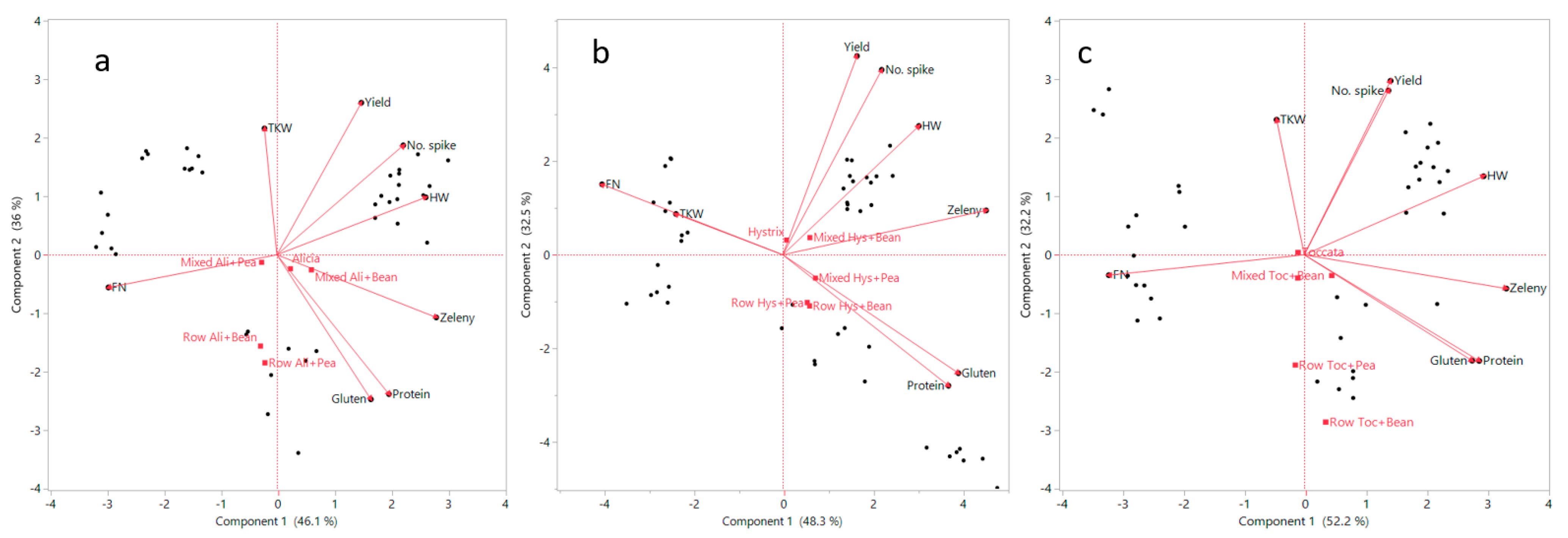
| Season | Ploughing | Seedbed | Sowing | Harrowing | Harvested | Days of Mature (Days) |
|---|---|---|---|---|---|---|
| 2020 | 11/2019 | 3/4/2020 * | 6/4/2020 | 27/4/2020 | 19/8/2020 | 134 |
| 2021 | 11/2020 | 29/3/2021 | 31/3/2021 | 19/4/2021 | 14/8/2021 | 136 |
| 2022 | 11/2021 | 28/3/2022 | 30/3/2022 | 4/4/2022 | 28/7/2022 | 120 |
| Factor | No. Spike | TKW (g) | Yield (t ha−1) | HW (kg hL−1) | Protein (%) | Gluten (%) | Zeleny (mL) | FN (s) |
|---|---|---|---|---|---|---|---|---|
| Harvest year | ||||||||
| Y2020 | 208.35 ± 8.88 b | 42.97 ± 0.44 a | 4.21 ± 0.11 b | 74.98 ± 0.23 c | 11.87 ± 0.07 c | 25.03 ± 0.26 c | 38.49 ± 0.47 c | 363.79 ± 2.93 a |
| Y2021 | 140.80 ± 7.06 c | 39.89 ± 0.57 b | 2.76 ± 0.11 c | 75.67 ± 0.19 b | 14.40 ± 0.08 a | 30.66 ± 0.40 a | 61.33 ± 0.88 b | 304.90 ± 6.72 b |
| Y2022 | 372.00 ± 9.61 a | 41.87 ± 0.46 a | 6.41 ± 0.10 a | 77.08 ± 0.11 a | 13.60 ± 0.04 b | 29.02 ± 0.13 b | 68.28 ± 0.74 a | 281.08 ± 2.45 c |
| Sowing method | ||||||||
| Mixed | 273.15 ± 12.35 a | 42.02 ± 0.38 a | 4.94 ± 0.19 a | 76.17 ± 0.17 a | 13.10 ± 0.14 a | 27.73 ± 0.35 a | 55.07 ± 1.70 a | 314.96 ± 5.38 b |
| Row-by-row | 239.25 ± 13.03 b | 41.68 ± 0.45 a | 4.53 ± 0.20 b | 75.70 ± 0.21 b | 13.11 ± 0.13 a | 27.94 ± 0.35 a | 55.22 ± 1.80 a | 322.63 ± 5.41 a |
| Variety | ||||||||
| Alicia | 261.05 ± 19.84 a | 39.51 ± 0.43 b | 4.80 ± 0.23 a | 77.02 ± 0.16 a | 13.24 ± 0.19 a | 29.25 ± 0.39 a | 58.09 ± 2.31 a | 333.78 ± 6.15 a |
| Toccata | 245.50 ± 12.62 a | 43.09 ± 0.44 a | 4.59 ± 0.24 b | 74.54 ± 0.21 c | 12.79 ± 0.16 b | 26.74 ± 0.40 c | 51.29 ± 1.73 c | 314.80 ± 6.90 c |
| Hystrix | 264.85 ± 17.08 a | 42.96 ± 0.47 a | 4.84 ± 0.25 a | 76.28 ± 0.16 b | 13.28 ± 0.14 a | 27.50 ± 0.40 b | 56.02 ± 2.22 b | 307.37 ± 6.29 b |
| Legume | ||||||||
| Wheat | 265.70 ± 17.49 a | 42.27 ± 0.49 a | 5.30 ± 0.23 a | 76.13 ± 0.20 a | 12.92 ± 0.19 b | 27.50 ± 0.46 c | 53.92 ± 2.28 c | 317.75 ± 4.73 b |
| Wheat x Pea | 256.15 ± 14.00 a | 41.55 ± 0.51 a | 4.42 ± 0.25 b | 75.59 ± 0.25 a | 13.22 ± 0.15 a | 27.77 ± 0.42 b | 55.36 ± 1.90 b | 322.49 ± 6.41 a |
| Wheat x Bean | 248.80 ± 15.54 a | 41.72 ± 0.54 a | 4.47 ± 0.23 b | 76.13 ± 0.24 a | 13.18 ± 0.15 a | 28.27 ± 0.39 a | 56.28 ± 2.20 a | 315.37 ± 8.65 c |
| ANOVA | ||||||||
| Year (1) | ** | ** | ** | ** | ** | ** | ** | ** |
| Sowing (2) | ** | ns | ** | ** | ns | ns | ns | ** |
| Variety (3) | ns | ** | * | ** | * | ** | ** | ** |
| Legume (4) | ns | ns | ** | ns | * | * | ** | ** |
| 2 × 3 | ns | ns | ns | ** | * | ** | ns | ns |
| 2 × 4 | * | ns | ** | ns | * | ** | ** | ** |
| 3 × 4 | ns | ns | ns | ns | * | ** | * | ** |
| 2 × 3 × 4 | ns | ns | ns | ns | * | ** | * | ** |
| No. Spike | TKW | Yield | HW | Protein | Gluten | Zeleny | FN | |
|---|---|---|---|---|---|---|---|---|
| No. spike | - | 0.05 | 0.83 * | 0.53 * | 0.04 | 0.04 | 0.45 * | −0.44 * |
| TKW | - | 0.13 | −0.24 * | −0.33 * | −0.49 * | −0.29 * | −0.02 | |
| Yield | - | 0.54 * | −0.07 | −0.04 | 0.38 * | −0.41 * | ||
| HW | - | 0.41 * | 0.50 * | 0.60 * | −0.41 * | |||
| Protein | - | 0.88 * | 0.84 * | −0.62 * | ||||
| Gluten | - | 0.78 * | −0.50 * | |||||
| Zeleny | - | −0.71 * | ||||||
| FN | - |
Disclaimer/Publisher’s Note: The statements, opinions and data contained in all publications are solely those of the individual author(s) and contributor(s) and not of MDPI and/or the editor(s). MDPI and/or the editor(s) disclaim responsibility for any injury to people or property resulting from any ideas, methods, instructions or products referred to in the content. |
© 2025 by the authors. Licensee MDPI, Basel, Switzerland. This article is an open access article distributed under the terms and conditions of the Creative Commons Attribution (CC BY) license (https://creativecommons.org/licenses/by/4.0/).
Share and Cite
Hlásná Čepková, P.; Hoang, T.N.; Konvalina, P.; Mühlbachová, G.; Capouchová, I.; Svoboda, P.; Čermák, T.; Janovská, D. Impact of Spring Wheat Varieties and Legume Species Intercropping on Organic Wheat Production. Agronomy 2025, 15, 1096. https://doi.org/10.3390/agronomy15051096
Hlásná Čepková P, Hoang TN, Konvalina P, Mühlbachová G, Capouchová I, Svoboda P, Čermák T, Janovská D. Impact of Spring Wheat Varieties and Legume Species Intercropping on Organic Wheat Production. Agronomy. 2025; 15(5):1096. https://doi.org/10.3390/agronomy15051096
Chicago/Turabian StyleHlásná Čepková, Petra, Trong Nghia Hoang, Petr Konvalina, Gabriela Mühlbachová, Ivana Capouchová, Pavel Svoboda, Tomáš Čermák, and Dagmar Janovská. 2025. "Impact of Spring Wheat Varieties and Legume Species Intercropping on Organic Wheat Production" Agronomy 15, no. 5: 1096. https://doi.org/10.3390/agronomy15051096
APA StyleHlásná Čepková, P., Hoang, T. N., Konvalina, P., Mühlbachová, G., Capouchová, I., Svoboda, P., Čermák, T., & Janovská, D. (2025). Impact of Spring Wheat Varieties and Legume Species Intercropping on Organic Wheat Production. Agronomy, 15(5), 1096. https://doi.org/10.3390/agronomy15051096






